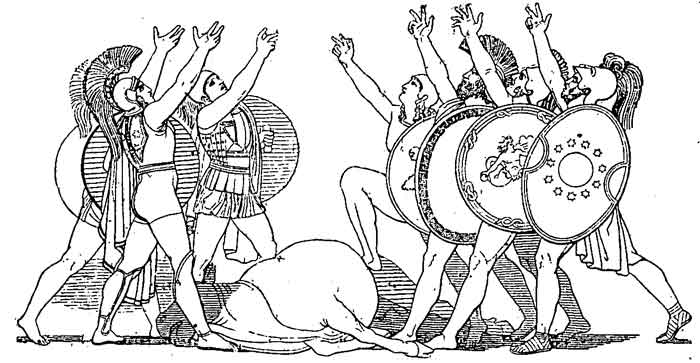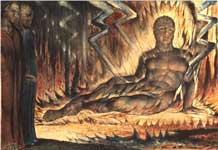In Greek mythology, Capaneus /kəˈpæn.juːs/ (Greek: Καπανεύς, Kapaneús) was a son of Hipponous and either Astynome (daughter of Talaus)[2] or Laodice (daughter of Iphis),[3] and husband of Evadne, with whom he fathered Sthenelus.[4] Some call his wife Ianeira.[5]
Mythology
According to the legend, Capaneus had immense strength and body size and was an outstanding warrior. He was also notorious for his arrogance. He stood just at the wall of Thebes during the war of the Seven against Thebes and shouted that Zeus himself could not stop him from invading it. Vegetius refers to him as the first to use ladders in a siege.[6] In Aeschylus, he bears a shield with a man without armour withstanding fire, a torch in hand, which reads 'I will burn the city,' in token of this. While he was mounting the ladder, Zeus struck and killed Capaneus with a thunderbolt, and Evadne threw herself on her husband's funeral pyre and died.[7][8][9][10][11][12] His story was told by Aeschylus in his play Seven Against Thebes,[13] by Euripides in his plays The Suppliants and The Phoenician Women,[14] and by the Roman poet Statius.[15]

Seven against Thebes, The Oath, Adrastus, Polynices, Capaneus, Parthenopaeus , Amphiaraus, Hippomedon, Tydeus , based on Flaxman
Evadne throws herself on the Funeral Pile of her Husband Capaneus, Edward Francis Burney

Capaneus scales the city wall of Thebes, Campanian red-figure Neck-amphora attributed to the Caivano Painter, ca. 340 BC, J. Paul Getty Museum (92.AE.86).
Popular culture
In the fourteenth canto of his Inferno, Dante sees Capaneus in the seventh circle (third round) of Hell. Along with the other blasphemers, or those "violent against God", Capaneus is condemned to lie supine on a plain of burning sand while fire rains down on him. He continues to curse the deity (whom, being a pagan, he addresses as "Jove" [Jupiter]) despite the ever harsher pains he thus inflicts upon himself, so that God "thereby should not have glad vengeance."
In Ezra Pound's poem "Hugh Selwyn Mauberly," Capaneus is mentioned, with the implication that Mauberly (and by extension Pound himself) shared the ancient hero's daring and over-confidence.
See also
List of Greek mythological figures
References
J. Paul Getty Museum 92.AE.86.
Hyginus, Fabulae, 70
Scholia on Euripides, Phoenician Women, 189; on Pindar,Nemean Ode 9. 30
Bibliotheca 3. 10. 8
Scholia on Pindar,Olympian Ode 6. 46
Vegetius. De re militari. 4.21.
Sophocles, Antigone, 133
Bibliotheca 3. 6. 6. – 3. 7. 1
Euripides, Suppliants, 983 ff
Hyginus, Fabulae, 243
Ovid, Metamorphoses, 9. 404; Ars Amatoria, 3. 21
Philostratus the Elder, Images, 2. 31
Aeschylus, Seven Against Thebes, 423 ff
Euripides, Phoenician Women, 1172 ff
Statius, Thebaid, 10. 927
---
See also : Greek Mythology. Paintings, Drawings
A - B - C - D - E - F - G - H - I - J - K - L - M -
N - O - P - Q - R - S - T - U - V - W - X - Y - Z
Α - Β - Γ - Δ - Ε - Ζ - Η - Θ - Ι - Κ - Λ - Μ -
Ν - Ξ - Ο - Π - Ρ - Σ - Τ - Υ - Φ - Χ - Ψ - Ω
| Ancient Greece
Science, Technology , Medicine , Warfare, , Biographies , Life , Cities/Places/Maps , Arts , Literature , Philosophy ,Olympics, Mythology , History , Images Medieval Greece / Byzantine Empire Science, Technology, Arts, , Warfare , Literature, Biographies, Icons, History Modern Greece Cities, Islands, Regions, Fauna/Flora ,Biographies , History , Warfare, Science/Technology, Literature, Music , Arts , Film/Actors , Sport , Fashion --- |


